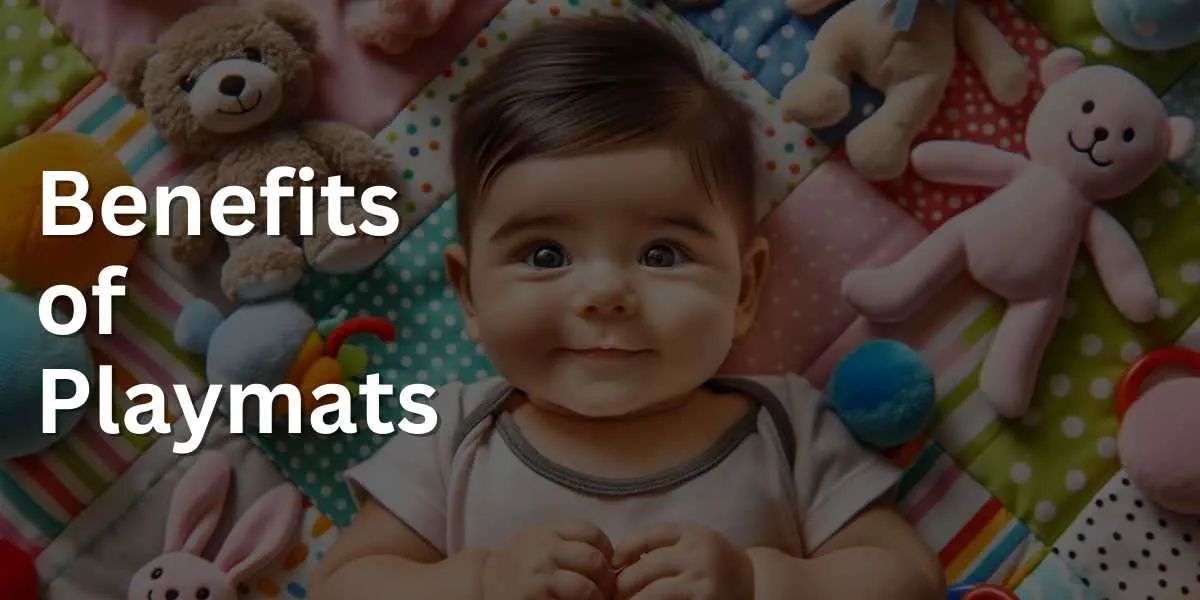Delving into the Benefits of a Playmat reveals more than just a soft surface for play. These mats, often adorned with colors, textures, and interactive elements, play a pivotal role in a child’s holistic development.
Playmats offer a dedicated and safe space for babies and toddlers to explore, encouraging tactile sensations, visual stimulation, and motor skill development. They facilitate activities like tummy time, rolling over, and crawling, paving the way for crucial developmental milestones. Moreover, playmats often incorporate elements that nurture cognitive skills, fostering pattern recognition, and problem-solving.
Curious about how a simple mat can transform your child’s playtime into a developmental adventure? Journey with us as we outline the enriched world of playmat benefits.
Key Takeaways: Benefits of a Playmat
- Safety and Comfort:
- Cushioning: Playmats provide a soft surface, protecting babies from hard floor impacts, especially when they are learning to roll over, sit up, or crawl.
- Defined Play Area: It offers a designated spot for play, keeping toys contained and ensuring they’re on a clean surface.
- Sensory Stimulation:
- Visual Exploration: Many playmats come with colorful patterns, shapes, and characters, stimulating an infant’s visual senses.
- Tactile Engagement: Different textures, flaps, or attached toys on the playmat encourage babies to touch, feel, and explore.
- Motor Skills Development:
- Tummy Time: Playmats are an excellent place for “tummy time,” which strengthens neck, shoulder, and arm muscles.
- Reaching and Grasping: Hanging toys or features on playmats encourage babies to reach out, enhancing their hand-eye coordination.
- Cognitive Development:
- Problem-Solving: Interactive features like mirrors, squeakers, or puzzles can foster curiosity and problem-solving skills.
- Spatial Awareness: Moving around on a playmat helps babies understand space, distance, and the relation between their body and the environment.
- Social Interaction:
- Bonding Time: Parents or caregivers can lie down or sit beside the baby, engaging in play, songs, or conversations.
- Peer Interaction: As babies grow, they can interact with siblings or other babies on the mat, promoting social skills.
- Portability and Versatility:
- Easy Setup: Most playmats are easy to fold and transport, making them suitable for both indoor and outdoor use.
- Multipurpose Use: Some playmats can be converted into ball pits or activity gyms, offering varied play options.
- Hygiene:
- Clean Play Space: Playmats provide a clean surface, especially useful in environments where floor cleanliness might be a concern.
- Washable: Many playmats are easy to wipe down or machine-washable, ensuring a hygienic play area.
- Encourages Independent Play:
- Self-Exploration: While interaction is essential, playmats also allow babies to explore and play independently, fostering self-entertainment and creativity.
What Are the Benefits of Playmats?
Playmats offer a myriad of advantages for both infants and parents, making them an essential accessory in a child’s early stages. Serving as a comfortable and cushioned surface, they protect babies from hard floors while giving them a dedicated space to explore and play. The vibrant colors and varied textures on many playmats stimulate visual and tactile development, encouraging babies to reach out, touch, and grasp. This, in turn, bolsters their fine motor skills.
For tummy time, playmats provide a supportive platform, crucial for muscle development and strengthening the neck, back, and shoulders. Many playmats also come equipped with attached toys or mirror features, promoting cognitive development and self-awareness. From a safety perspective, these mats offer a hygienic play area, isolating the child from dust and potential allergens.
For parents, playmats are easily portable and can be a sanctuary where they know their child is entertained and safe, giving them a moment’s peace in their hectic day.
Activity mats or play mats are probably one of the most versatile children accessories you can buy on the market. You can use them at home or on-the-go because of their portability.
Most playmats are easy to clean which is very convenient especially for busy parents. And these playmats provide protection against cold hard floors, dusts, germs and bacteria.
There are many benefits to having a playmat. You can use one to put your baby on for tummy time. Tummy time is encouraged for newborn babies to prevent developing a flat head and for the development of their neck and shoulder muscles.
Strengthening the neck and shoulders would allow babies to crawl when they grow older which is a considered one of the most important developmental milestones. Most playmats are brightly coloured and a good way to improve a baby’s visual acuity

Playmats also provide a clean and safe surface for babies and toddlers to play their favourite toys. You can put your baby on a playmat and play games that help her develop her hand eye coordination.
For example, you can dangle a soft toy like a doll or a plushie in front of her and have her reach for it or kick it.
Child development experts tell us that fine motor skills are some of the essential skills that should be developed at a young age. These skills are more precise in nature and would help children perform purposeful movements and actions when they grow older.
When she starts to crawl, fill the playmat with educational toys that are soft. You can put her favorite animal plushie or rattle. Letting her crawl on the playmat gives her a sense of freedom and allows her to freely explore her surroundings.
Playmats somehow encourage babies to crawl and use their legs and arms which are good for developing muscle strength. It prepares them for the next development milestones such as sitting upright.
These skills allow us to do simple actions like standing, walking, jumping, running and more. Depending on what your child can do, a playmat is a good accessory to use for developing skills. Babies fall several times before they could learn how to sit or stand. Playmats, especially those made with foam provide cushion.
When buying a playmat, choose something that you can use as teaching tools for lessons later on. For instance, there are many playmats that feature animal prints or numbers or alphabets.
These are great playmats to stimulate your baby visually and at the same can be used later on for teaching her about the alphabet, colours and basic numeracy.
Should You Buy a Baby Play mat?
Baby play mats are definitely worth the buy. If you are still on the fence about buying one for your little one, don’t be because buying a baby playmat is going to be one of the best decisions you will make.
You would never know when you would be needing one but knowing that you have one can be handy.
If you do not know what a playmat is, it is a playing surface usually made from soft materials. One thing to keep in mind when using a playmat is that you use it when your baby is away and under adult supervision. Never leave your baby alone on a playmat.
Playmats come in different types, sizes, colors and illustrations. Some playmats are designed for young children in mind. These playmats are softer and provide ample cushion to absorb impact from accidental stumbles and falls.
Playmats made from foam and other soft materials are particularly good for children. These are good playmats to put young children on during tummy time and when they start to learn how to crawl.
Some playmats even come with sensory toys. There are variants that come with mini-pianos and dangling toys that infants can try to reach and kick.
Creating a Safe and Stimulating Play Space for Your Little One with a Baby Play Mat
Babies need exercise and playmats are good baby accessories for that purpose. Tummy time is encouraged to prevent flat heads and to strengthen baby’s neck and shoulder muscles. When young children start crawling, they need to practice lifting their bodies to develop arm and leg strength.
- Comfort and protection: Play mats provide a soft, padded surface for children to play on and protect them from hard floors. This can help to prevent injuries from falls and provide a comfortable place for your child to play and relax.
- Stimulation and development: Many play mats come with built-in toys and activities that are designed to stimulate a child’s senses and promote cognitive development. This can help to engage and entertain your child, and support their early learning and development.
- Versatility and portability: Play mats can be used for a variety of activities, including tummy time, playing with toys, and reading books. They can also be easily folded or rolled up for storage when not in use, making them a versatile and convenient option for parents on the go.
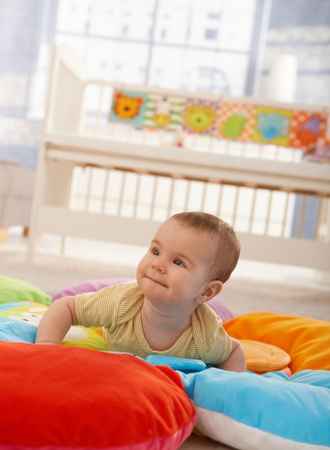
When to Buy a Baby Play Mat
When to buy a playmat entirely depends on you. You can start using it from day 1 but most parents don’t start using a baby playmat until their babies are 3 weeks old.
Initially, you would use a playmat as an added padding to provide cushion for your baby so she can easily adapt to life outside of the uterus.
At around 3 weeks, you would start encouraging your baby to reach out to the object using her hands for hand eye coordination and fine motor skills exercises. Try offering her a soft toy by dangling it in front of her.
Once your baby starts playing with her toys, you need something to protect her from dust, germs and bacteria that are normally found on floors. You want a playmat so that your baby can safely play with her toys and develop her skills.
Remember that babies are natural explorers and they love to crawl and explore the world around them. Providing them with a clean and safe play environment should be at the top of your list.
You can encourage them to explore more and make their own discoveries. This will boost their confidence and they learn more about themselves and their surroundings. If you are worried about accidental bumps and falls, you can surround your baby with soft toys like dolls and plushies.
Play with her on a playmat during her playtime and teach her about colours, numeracy, animals and more.
When can your baby use a playmat?
Some parents start using playmats from day one. Of course these parents took precautions like using padded cushions to make sure that their babies are lying on a soft surface.
Some pediatricians would suggest waiting until your baby’s umbilical cord falls off before you start putting your baby on the playmat for tummy time.
But it is highly recommended to ask your doctor about tummy time and the best time to start doing it to your baby.
You can dangle toys in front of your baby and watch her try to reach for the toy. This is good practice that helps strengthen her shoulders and arms.
Generally, most parents start putting their babies on a playmat between ages three to six months. During this time, babies start exploring their surroundings using their hands and mouths.
You can try offering her clean household objects like cardboard boxes or even toys like stacking cups.
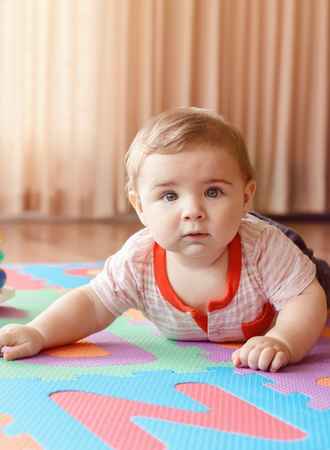
Are playmats good for tummy time?
Yes, playmats are definitely good for tummy time. All babies need tummy time and there are many ways to do it. One of the most popular ways is to put a baby on a playmat for tummy time.
Tummy time is placing a baby on her stomach while she is awake and under adult supervision. It is an important form of baby exercise because it facilitates a baby’s physical development like strengthening neck and shoulder muscles.
One good approach to tummy time is allowing a baby on her stomach for 5 minutes at a time. As soon as she is used to tummy time then make it a bit longer. This boosts tummy time and good mini-work out for babies.
How to Pick the Best Playmat or Gym for Your Baby
Playmats are interactive mats that are often brightly colored which are good accessories for babies’ play time. This baby gear comes in a wide range of sizes, shapes and illustrations. Some playmats even come with toys for babies to kick and try to reach.
These playmats provide a safe environment for babies to exercise, play and develop their skills, body strength and many more. When babies get older, they need something to interact with and play on.
This is where playmats come in. Baby playmats are perfect for babies who have not learned how to crawl yet.
Features
Some playmats feature reversible sides which actually is a good feature to keep things fresh and interesting for your little one. Choose a playmat that has bright colors and features child-friendly prints that you can use as teaching tools later on.
For instance, some playmats that feature different animals and playful prints while other play mats feature different textures, shapes and colors are good for teaching little kids about animals, their first colors and basic numeracy. You might want light up keys, a tummy time pillow, light up star, a play space cover, a ball pit, a musical sheep or a combined activity gym and play mat.
Many parents consider playmats as the perfect toy because these toys are washable and provide hours upon hours of entertainment. If budget is not an issue, there are playmats that come with a bunch of other toys but these playmats often come with a hefty price tag. Some even convert into a cozy fort for older babies.

Safety
Some parents, especially first-time parents find it a bit daunting to find the right playmat for their babies. Playmats are also the perfect gifts for new parents or anyone expecting a baby. The best baby playmats should be safe and easily cleaned when they get dirty. Safety should always be at the top of every parents list and that includes anything from toys to playmats.
One of the most important features to consider when buying a playmat is its safety. A playmat should be soft and provide enough cushion for the baby. It should be softer than the floor so that it can absorb the impact from accidental falls and stumbles on hardwood floors.
Babies often fall unintentionally so it is highly recommended to surround them with soft objects and toys like plushies and dolls. There are also playmats that are thick and spongy. These kinds of playmats are best for hard floors and protect little children from cold floors and little bumps.
Cleaning
Another thing to consider is the washability of the playmat. Waterproof playmats are probably the most popular kind of play because these playmats are easy to wipe clean. All you need to do is spritz soapy water from a spray bottle into the area of the playmat that is dirty and wipe it down gently with a clean damp cloth.
Little children love sitting and playing with their toys. Playmats allow children to have an uninterrupted fun play time with their toys while leaning more about themselves and the world around them as well as developing their essential skills. Playmats also protect children from dust and germs that are often found on surfaces of floors.
What are the Best baby play mats?
It is difficult to determine the “best” baby play mats as different play mats may be better suited for different individuals and their needs. Here are a few factors to consider when looking for a baby play mat:
- Age-appropriateness: Look for a play mat that is designed for your child’s age group. Play mats for younger babies may have different features and activities than those for older children.
- Materials: Choose a play mat that is made of safe and non-toxic materials. Look for play mats that are free of harmful chemicals such as BPA and phthalates, you may even want machine washable mats as they are much easier to keep clean! You can also choose an activity mat that is made from organic cotton and come with a soft place for your growing baby.
- Certifications: Look for play mats that have been certified by reputable organizations, such as the Juvenile Products Manufacturers Association (JPMA) or the Consumer Product Safety Commission (CPSC).
- Features and activities: Consider the features, activities and mouthable accessories that the play mat offers. Look for play mats that have overhead toys and activities that will engage and stimulate your child’s senses and promote cognitive development.
- Size and portability: Consider the size of the play mat and whether it will fit in your desired safe space. Some play mats may be too large for a small nursery or playroom, while others may be too small for older children. Look for play mats that can be easily folded or rolled up for easy storage when not in use.
This play mat is our overall winner though, for its all round adaptability.
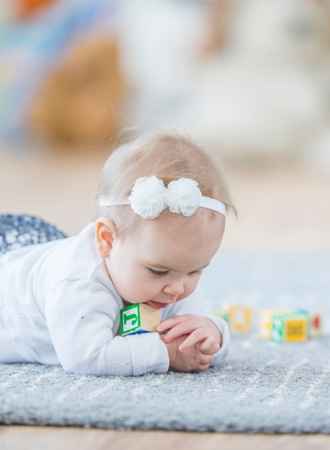
FAQs on Baby Play Mats
What is a Playmat?
A play mat is a large, padded mat that is used for infants and young children to play on. The purpose of a play mat is to provide a soft, comfortable surface for children to play on and to protect them from hard floors.
Play mats often come with various features, such as either removable toys or detachable toys, or sometimes even both, to stimulate and engage a child’s senses and good for developing skills.
Play mats are often used in a child’s nursery or playroom and can be easily folded or rolled up for storage when not in use.
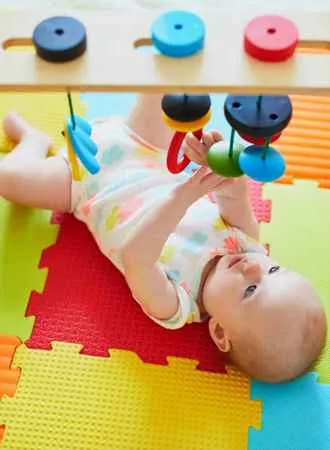
What is the difference between a playing mat and a play gym?
A play mat and a play gym are similar in that they are both used for infants and young children to play on. However, there are some key differences between the playmats and play gyms.
A play mat is a large, padded mat that is used for infants and young children to play on. It is typically placed on the floor and provides a soft, comfortable surface for children to play on and to protect them from hard floors.
Play mats often come with various features, such as fun toys, tummy time prop and activities, to stimulate and engage a child’s senses and promote cognitive development. Play mats are often used in a child’s nursery or playroom and can be easily folded or rolled up for storage when not in use.
Baby gyms, on the other hand, are a freestanding structure that typically consists of a frame with hanging toys and a padded mat on the bottom.
If you plan to get a baby gym, choose a play gym designed to provide a safe and stimulating environment for infants to play and develop important motor skills. The hanging toys on a baby activity gym are designed to encourage a child to reach, grab, and interact with their surroundings, while the padded mat provides a comfortable place for the child to lie on.
Play and activity gyms are often used in a child’s nursery or playroom, but can also be used outdoors in a safe and sheltered area. You can have both a gym and a round mat or even a gym mat, they work very well together.

